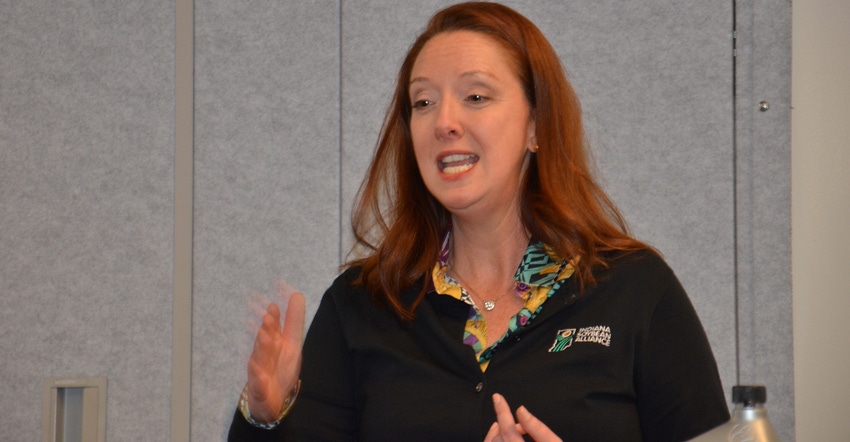
Leaders of the Indiana Soybean Alliance and Indiana Corn Marketing Council have set the stage for three years of growth. A committee made up of six farmer-leaders and five association or council staff members worked for 11 months to arrive at a detailed road map for the future.
“Failing to plan is planning to fail,” says Mark Legan, Coatesville, Ind., an ISA director and representative on the U.S. Meat Export Federation board. “We feel like we now have a good plan, which will help our groups move forward.”
“We had more farmers than staff people involved for a reason,” adds Courtney Kingery, CEO of both groups, plus the Indiana Corn Growers Association. She just completed one year in her new role. “We wanted it to be farmer-driven, and it was. They have laid out a road map with clear signals for what they want the staff to focus on during the next three years, and set benchmarks in these various areas to measure progress. Staff members who support various activities now have clear direction on where to focus their efforts.”
Strategic plan components
ISA and ICMC wound up with similar plans, both with four key components: market development, sustainability, value creation and producer engagement. Here is a closer look at each component:
Market development. “Some of us think of this as ‘moving the pile,’” Legan says. “We’re really good at growing corn and soybeans. The goal with this objective is helping develop more markets for what we grow.”
Increasing meat and poultry exports to target customers globally is a big goal, Legan explains. He notes that already today, if soybeans are $10 per bushel, $1 of that total is due to pork exports alone, not counting domestic consumption or exports of other meats and poultry. The potential for increasing poultry exports is huge, he says. Target markets for meat and poultry exports include South Korea, China, Japan, Mexico and Colombia.
ISA also will work with the U.S. Soybean Export Council, targeting South Korea and Colombia as countries where soybean exports could increase.
“We need to diversify our marketing and not just rely on one customer, like China,” Legan says.
Sustainability. “There are three parts,” explains Josh Miller, president of ICMC and a representative to the U.S. Grains Council. Miller and his family farm in Madison County, Ind. “There are environmental, social and economic pieces as we look at sustainability.
“First, we need more farmers to buy into managing soil health, using cover crops, no-tilling and developing nutrient management plans. Many farmers are already doing this, and that’s part of the social aspect — we need to make consumers aware of what farmers are already doing to protect the environment.
“The economical aspect is near and dear to my heart. We don’t want to use any more nutrients than necessary, because applying more than we need costs us money. It hurts the environment at the same time. Cover crops and other soil health practices can help us achieve our goals.
“We don’t want to overapply nutrients and be wasteful. We need to spread this message.”
Value creation. “We want to continue looking for new ways to use corn and soybeans, and supporting those ways that appear to have the most potential,” says Sarah Delbecq, ICMC treasurer and immediate past president of ICGA. She and her husband farm in DeKalb County, Ind.
“At one time, ethanol was a new use, and look at where it is today — and you could make a similar case for biodiesel fuel from soybeans,” she says. “Many successful products have come out of the new uses for soybean competition at Purdue University, which we support, including soy crayons, soy candles and many more.”

The strategic plans for both groups still allow support of research projects with checkoff funds, especially if the research helps meet one of the main goals in the plan, Kingery says. Delbecq believes searching for new uses is one area where supporting research makes sense.
“What we must focus on going forward is learning how far to go with a potential new use, and realize that at some point, it may be necessary to realize it just isn’t going to take off,” Delbecq adds. “Then we put our resources behind other projects and products that could more likely make it and increase demand.”
Producer engagement. “We have a strong story to tell as producers, but we need to look for the most efficient ways to tell it to farmers and consumers,” says Kevin Cox, an ISA director from Parke County, Ind. “I believe in what we’re doing and realize it’s important to get more farmer-members to understand the value of what checkoff dollars can do for them.
“There’s good data to show that for every $1 invested in checkoff programs like ours, we reap $10 to $12 in returns down the road. We need to get this message out to members, through social media, meetings, radio, magazines and whatever it takes.”
Cox is serious about involving more farmers. “This entire strategic plan is not just an ‘Elf on the Shelf’ exercise, where ‘we’ve done it, so we put it on the shelf’ and go on our way. Instead, we intend to pursue each one of these goals, working with staff members, and measure our success.”
About the Author(s)
You May Also Like




